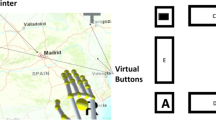Abstract
The context of mobility raises many issues for geospatial applications providing location-based services. Mobile device limitations, such as small user interface footprint and pen input whilst in motion, result in information overload on such devices and interfaces which are difficult to navigate and interact with. This has become a major issue as mobile GIS applications are now being used by a wide group of users, including novice users such as tourists, for whom it is essential to provide easy-to-use applications. Despite this, comparatively little research has been conducted to address the mobility problem. We are particularly concerned with the limited interaction techniques available to users of mobile GIS which play a primary role in contributing to the complexity of using such an application whilst mobile. As such, our research focuses on multimodal interfaces as a means to present users with a wider choice of modalities for interacting with mobile GIS applications. Multimodal interaction is particularly advantageous in a mobile context, enabling users of location-based applications to choose the mode of input that best suits their current task and location. The focus of this article concerns a comprehensive user study which demonstrates the benefits of multimodal interfaces for mobile geospatial applications.










Similar content being viewed by others
References
Doyle J, Bertolotto M, Wilson D (2007) A survey of multimodal interfaces for mobile mapping applications (book chapter). In: Meng L, Zipf A, Winter S (eds) Map-based mobile services—interactivity and usability, chapter 8. Springer-Verlag book series in geo-information and cartography. Springer, Berlin Heidelberg New York, pp 146–166
Doyle J, Bertolotto M, Wilson D (2007) Multimodal interaction—improving usability and efficiency in a mobile GIS context. In: International conference on advances in computer-human interaction (ACHI 08). IEEE, New York, pp. 63–68
Egenhofer M (1997) Query processing in spatial-query-by-sketch. J Vis Lang Comput 8(4):403–424
Fuhrmann S, MacEachren A, Dou J, Wang K, Cox A (2005) Gesture and speech-based maps to support use of GIS for crisis management: a user study. In: AutoCarto 2005. Cartography and Geographic Information Society, Gaithersburg
International Organisation for Standardization (2007) ISO 9241-11—Guidance on usability. http://www.iso.org. Accessed 2007
Keiffer S, Carbonell N (2006) Oral messages improve visual search. In: AVI ’06, the working conference on advanced visual interfaces. ACM, New York, pp 369–372
Kreuger A, Butz A, Muller C, Stahl C, Wasinger R, Steinberg KE, Dirschl A (2004) The connected user interface: realizing a personal situated navigation service. In: 9th international conference on intelligent user interfaces (IUI 04). ACM, New York, pp 161–168
Malaka M, Zipf A (2000) DEEP MAP—challenging IT research in the framework of a tourist information system. In: 7th international congress on tourism and communication technologies in tourism (ENTER 2000). Springer LNCS, Berlin Heidelberg New York, pp 15–27
Oviatt S (1996) Multimodal interfaces for dynamic interactive maps. In: SIGCHI conference on human factors in computing systems, Vancouver, 13–18 April 1996, pp 95–102
Oviatt S (2000) Taming recognition errors with a multimodal interface. In: Communications of the ACM, vol 43, no 9. ACM, New York, pp 45–51
Oviatt S (1999) Mutual disambiguation of recognition errors in a multimodal architecture. In: CHI ’99. ACM, New York, pp 576–583
Oviatt S (2003) Multimodal interfaces. In: Jacko J, Sears A (eds) Handbook of human–computer interaction. North Holland, Amsterdam, pp 286–304
Rauschert I, Sharma R, Fuhrmann S, Brewer I, MacEachren A (2002) Approaching a new multimodal GIS interface. In: 2nd international conference on GIS (GIScience), Boulder, September 2002
Sharma R, Pavlovic V, Huang TS (1998) Toward a multimodal human computer interface. Proc IEEE 86(5):853–869
Suhm B, Myers B, Waibel A (2001) Multimodal error correction for speech user interfaces. In: ACM transactions on computer-human interaction (TOCHI), vol 8, no 1. ACM, New York, pp 60–98
Wasinger R, Stahl C, Kreuger A (2003) M3I in a pedestrian navigation and exploration system. In: 5th international symposium on human computer interaction with mobile devices (Mobile HCI 03). Springer LNCS, Berlin Heidelberg New York, pp 343–346
Wilson D, Doyle J, Weakliam J, Bertolotto M, Lynch D (2006) Personalised maps in multimodal mobile GIS. International Journal of Web Engineering and Technology, sepcial issue on Web and Wireless GIS. Inderscience Publishers 3(2):196–216
Wickens CD, Baker P (1995) Cognitive issues in virtual reality. In: Furness TA, Bakerfield W (eds) Virtual environments and advanced interface design. Oxford University Press, Oxford, pp 514–541
Acknowledgements
Research presented in this paper was funded by a Strategic Research Cluster grant (07/SRC/I1168) by Science Foundation Ireland under the National Development Plan. The authors gratefully acknowledge this support.
Author information
Authors and Affiliations
Corresponding author
Rights and permissions
About this article
Cite this article
Doyle, J., Bertolotto, M. & Wilson, D. Evaluating the benefits of multimodal interface design for CoMPASS—a mobile GIS. Geoinformatica 14, 135–162 (2010). https://doi.org/10.1007/s10707-009-0079-2
Received:
Revised:
Accepted:
Published:
Issue Date:
DOI: https://doi.org/10.1007/s10707-009-0079-2




